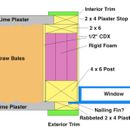How do you detail the exterior of an “outie” window in a straw bale home?
We plan on building a “pretty good” straw bale home in Tucson AZ, and I’m trying to think my way through a window installation. I know that most straw bale builders shape/curve the inside of their window openings to let in more light, but I don’t care for this. Not only is it a pain to stuff those curves and get plaster to stay on them, but I want thick window trim (craftsman bungalow style) which is sort of impossible with curved windows. So we plan on building plywood boxes for our rough openings. We DO plan on having wide windows (or banks of windows) to cut down on the cave-like feeling of narrow windows with 18″ deep walls. So that’s why we’re using plywood boxes.
My question is: how do you detail an outie window in a straw bale home so that you can add exterior window trim, but if the windows ever need replacing, the plaster won’t have to be ripped out?
Here’s what I was thinking (see crude plan view drawing). Does this seem feasible? Would you rabbet the back of the 2 x 4/ plaster stop to fit over the nailing fin? Or would you attach the nailing fin TO the exterior plaster stop, and then trim over the nailing fin? No need for any J channel or brick moulding on the window, right? Are there other major issues I’m missing?
Thank you for your help, and for everything you do here at GBA!
Michael
ps. the drawing is not to scale and leaves out all kinds of stuff like flashing and air sealing and jamb extensions and the wire mesh for the bales etc. be nice.
GBA Detail Library
A collection of one thousand construction details organized by climate and house part










Replies
I've been laying awake at night thinking about the same thing.
My straw bale house is in the final stages and currently the exterior needs its final lime plaster coat followed by the finished trim. Your drawing resembles what I will be doing for the stiles (vertical) and the bottom rail, however the top horizontal trim piece is the real dilemma.
It has to include proper flashing under the final plaster coat and then lap/fold/bend over the top trim. The problem is how to adhere plaster to the metal flashing with the ability to remove the trim and window in the future if need be.
Quick drawing on what I plan to do.
https://www.dropbox.com/s/4zkjdypi19voww3/Straw%20Bale%20Window%20Trim%20Flashing.PDF
One other suggestion is to place a heavy bead of silicon inside the rabbit cut (or in the inside corner created with the overlapping of trim boards). This will help stop excessive air movement with the seasonal movement of materials.
I'd like to hear from others too on any alternative detail they have tried.
Good luck. You're going to love your straw bale home. I've been living in mine for over a year now!
Cheers!
This is a good case for not using the nailing fin even while placing the window at the exterior.
The layering gets more complicated as you look at the pan and head. It seems like it would be more straight forward to flash as you would an innie. But one that is farther out than normal.
This means that simple pan flashing can be applied with an additional metal pan to drop over the trim or plaster.
Add a good interior air barrier like Siga Corvum 12/48 and it becomes pretty reliable.
Michael,
I agree with Albert: if one of your main concerns is ease of window replacement, then I think you should order windows without nailing flanges, and install them with clips.
You don't seem to have any questions about flashing the opening, so I'll assume that you have the situation under control. But just as a reminder, I'll quote John Straube's words from my article, Straw-Bale Walls:
“The fundamental requirement [for window sills] is that there be an outer layer of cladding, with a drainage gap below and a waterproof layer below that. You also need an opening to let the water out. You can use a Benjamin Obdyke product to create the drainage gap, or in a dry climate, you can use two layers of building paper. You also need some type of flashing with a drip edge and an exit slot for the water.”